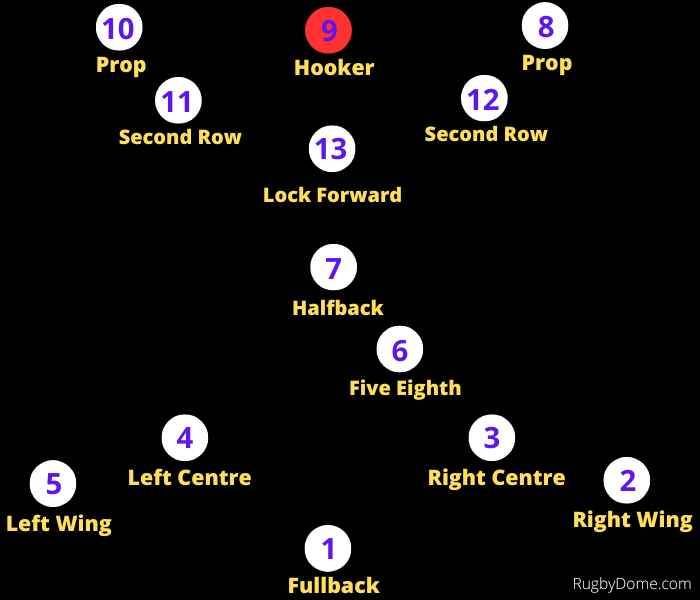There is one hooker on a rugby league team. They are part of the six forwards on the team.
Hookers traditionally wear the number nine jersey. This article looks at the crucial role of rugby league hookers in attack and defence.
We have a separate article on the role of hookers in rugby union.
Positioning
Although scrums aren’t a big part of modern rugby league, they are still used to restart play in various scenarios. The hooker is positioned in the front row of the scrum.
The hooker lines up between the two props. This picture shows the alignment:

Role Of Hookers In The Scrum
To start the scrum, the hooker crouches with the two props on either side. The props bind onto the hooker by wrapping one arm around his torso.
Hookers must maintain a strong, stable body position with their feet shoulder-width apart and their back straight.
When the halfback feeds the ball into the tunnel between the opposition packs, the number nine must ‘hook’ the ball back with their foot. That’s how they got their name of “hooker”.
Now that teams don’t push in the scrum, this is less of a challenge. However, hookers still must get their striking technique right.
This means using their foot to quickly and accurately foot-tap the ball back toward their team.
Their timing must be in sync with the halfback so that they strike the ball effectively.
What Do Hookers Do In Attack?
Hookers are crucial in attack as they often play the role of dummy half. That’s the player who takes up the position directly behind the play-the-ball after a tackle.
When they pick up the ball, they initiate the next phase of play by either:
- passing it to a teammate (often the halfback)
- running with the ball to exploit a gap in a disorganized defense
- executing a grubber kick to catch the opposition by surprise (the rarest option)
The hooker must have excellent passing skills to ensure that the ball is distributed effectively. As dummy half, they pass the ball more than most backs.
They should also have quick pace from a standing start to snipe for gaps.
The hooker can use deception, such as dummy passes or feints, to confuse the defenders and create gaps in the defensive line. This can lead to line breaks or opportunities for other attacking players.
Role Of Hookers In Defence
Hookers are more prominent in attack but they also play their part in defense.
Because they are often in a central position on the field, they have a vital role in communicating with their teammates and ensuring the defensive line stays connected.
Marker defense
As well as making a significant number of tackles throughout a game, the hooker often acts as a marker. This is when the opposition is executing a play-the-ball. The defending team is always trying to limit the available options.
They do so by having two markers stand directly in front of the play-the-ball to prevent the half from making a direct break or exploiting gaps around the sides of the ruck area.
The hooker is often one of the two markers.
Famous Hookers In Rugby League
Here are two famous hookers from two different countries.
Cameron Smith
Smith is considered to be one of the greatest league players in the history of the sport.
He joined the Melbourne Storm when he was nineteen. His early games were at halfback, but he switched to hooker in his second season.
Smith captained the Storm for fifteen years and drove them to three NRL titles. He remains the highest points scorer ever.
He also won the Golden Boot twice as international player of the year.
James Roby
Roby grew up in Merseyside and went to Liverpool University to study sports science. He left to play league full-time.
He joined the St Helens academy and made his professional debut in 2004. He played off the bench in his first two seasons as a teenager. Roby soon had the position of starting hooker.
He was the youngest winner of the Man Of Steel award in 2007. He was man-of-the-match when St Helens won the 2014 Super League Grand Final. He broke the league’s appearance record in 2022.
Roby got his first international cap in 2006. He played for England in the World Cups of 2008, 2011, and 2017.